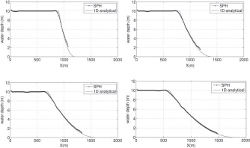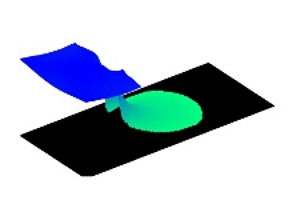







SWE-SPHysics
From SPHYSICS
(Difference between revisions)
| Line 1: | Line 1: | ||
| − | The two-dimensional shallow-water equations (SWEs) are widely used to approximate flows for a wide range of rapidly (and slowly) varying free-surface flows, such as dam breaks, river flooding, and tidal flows including storm surge and wave overtopping causing inundation in estuaries and coastal regions. Grid-based solvers are now widely available. Although accurate and robust wetting and drying routines have been developed, grid-based solvers are limited in simulating multi-phase effects, most importantly flows with rapid distortion in flood modelling | + | {| width="85%" |
| − | + | |- | |
| − | Here, the SPHysics numerical scheme, originally developed to solve Navier-Stokes Equations has been extended to shallow water equations. | + | |The two-dimensional shallow-water equations (SWEs) are widely used to approximate flows for a wide range of rapidly (and slowly) varying free-surface flows, such as dam breaks, river flooding, and tidal flows including storm surge and wave overtopping causing inundation in estuaries and coastal regions. Grid-based solvers are now widely available. Although accurate and robust wetting and drying routines have been developed, grid-based solvers are limited in simulating multi-phase effects, most importantly flows with rapid distortion in flood modelling. |
| + | |- | ||
| + | |Here, the SPHysics numerical scheme, originally developed to solve Navier-Stokes Equations has been extended to shallow water equations. | ||
| + | |- | ||
| + | | | ||
Key code features: | Key code features: | ||
| Line 12: | Line 16: | ||
* Bed Topography Representation | * Bed Topography Representation | ||
* Viscosity & Stabilisation terms | * Viscosity & Stabilisation terms | ||
| + | |||
The code comes with the following test cases: | The code comes with the following test cases: | ||
| + | |} | ||
{|cellpadding="10" width="85%" | {|cellpadding="10" width="85%" | ||
Revision as of 22:22, 12 February 2014
| The two-dimensional shallow-water equations (SWEs) are widely used to approximate flows for a wide range of rapidly (and slowly) varying free-surface flows, such as dam breaks, river flooding, and tidal flows including storm surge and wave overtopping causing inundation in estuaries and coastal regions. Grid-based solvers are now widely available. Although accurate and robust wetting and drying routines have been developed, grid-based solvers are limited in simulating multi-phase effects, most importantly flows with rapid distortion in flood modelling. |
| Here, the SPHysics numerical scheme, originally developed to solve Navier-Stokes Equations has been extended to shallow water equations. |
|
Key code features:
|
1-D Test Cases
|
2-D Test Cases
|
How to reference: How to reference SWE-SPHysics.

